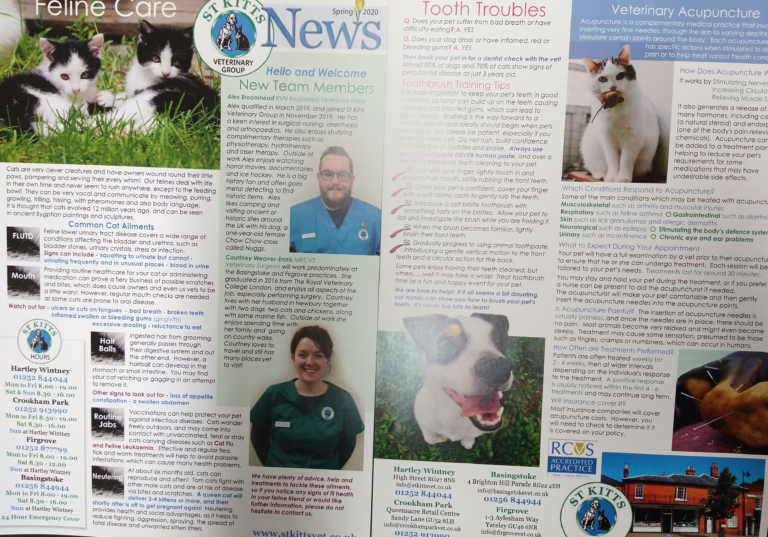
For all the latest practice news and health information, check out our newsletter in the link below!
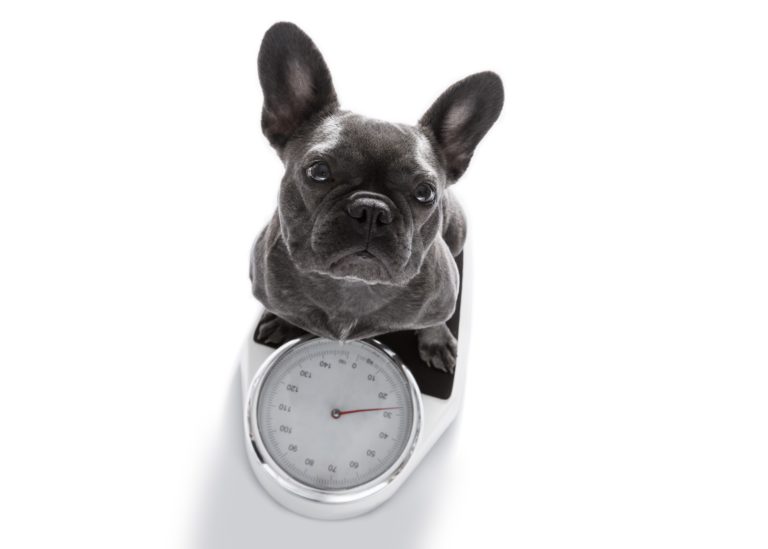
The number of overweight pets is unfortunately growing in the UK. If left unchecked, what started as a bit of excess weight can lead to obesity which brings with it some very serious health issues for your pet including diabetes, heart disease and cancer.
It is therefore important to keep an eye on your pet’s weight and if you think they may be overweight, address it straight away. This will help ensure that your pet enjoys a long, happy and healthy life.
There are a number of checks you can use to establish whether your pet is overweight.
1. You should be able to see and feel the outline of your pet’s ribs and be able to feel your cat and rabbit’s spine and hip bones too. They should feel rounded though, not sharp which would indicate an underweight animal.
2. Your dog or cat’s waist should be clearly visible from above although if it’s a long haired breed, this may be more difficult.
3. A dog’s belly should be tucked up when viewed from the side and a cat’s shouldn’t be sagging down.
Measure portions – Check that you are feeding your pet the correct portion size. Follow advice on the food packaging regarding size, age and lifestyle. If your pet is on the chubby side, give them slightly less until they are looking slimmer.
Get them moving more – Increase the length of your dogs walk or add another walk to your usual routine. Even a few more minutes playing in the park can help burn calories. It’s not just kittens that are playful, older cats can be encouraged to play and a couple of 10-15 minute play sessions with your cat can help with weight issues.
Manage treats – Keep an eye on the type of treats your pet is given. Human food given as treats can cause your pet to pile on the pounds so it’s better to stick to those specifically designed for animals, remembering to limit the number given.
Don’t assume they are hungry – Just because they look as though they are begging for your food, it doesn’t necessarily mean they want it. They may be after your attention so try a pat on the belly or scratch behind the ear instead of giving tidbits.
If you have concerns over whether your pet is a healthy weight, please get in touch. We can carry out a health check and recommend a weight reduction programme if necessary.
St Kitts Veterinary Centre: 01252 844044
Basingstoke Veterinary Centre: 01256 844944
Crookham Park Veterinary Centre: 01252 913990
Firgrove Veterinary Centre: 01252 877799
We are running a free, educational evening for our clients on Thursday 30th January 2020 at our Firgrove Veterinary Practice in Yateley. Come and join us for an evening of simple, powerful advice on weight management for your pet, delivered by people who care and aren’t going to pass judgement. We look forward to seeing you there!

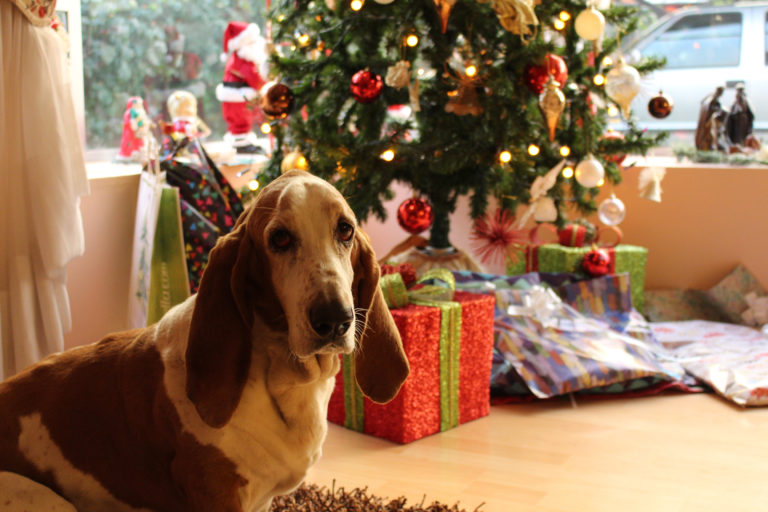
For many of us Christmas is a busy and exciting time of year! However for your pet, the festive period can be fraught with potential dangers to their health and wellbeing.
Reduce the risk of an emergency trip to the vet and ensure the whole family has a very merry Christmas by taking note of the advice below.
1. Real Trees
The oils found in fur trees are mildly toxic to pets and can cause a tummy upset if ingested. The needles can easily become lodged in a paw or throat so make sure fallen needles are cleared up promptly and ensure pets aren’t left unsupervised near the tree.
2. Decorations & Lights
Rabbits, cats and dogs have all been known to chew through wires so make sure your cables are tucked away safely. Baubles can look just like toys to pets! They may want to play with them – resulting in broken glass and potential damage to paws, chew them or even eat them which can often mean a visit to the vet. Also, ensure any chocolate tree decorations are out of reach!
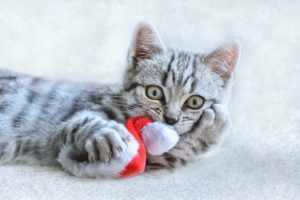
3. Dangerous Foods
4. Poisonous Floral Decorations
Poinsettia, Mistletoe, Amaryllis and Holly are Christmas favourites but they are dangerous for pets. With varying levels of toxicity, the side effects depend on how much of the plant is consumed. Display them well out of reach to avoid any tummy troubles.
5. Keep Pets Happy
Christmas time often means a busy home, with friends and family coming together to celebrate. Unfamiliar people and more noise can be frightening for your pet so it’s a good idea to provide them with a safe room where they can escape and feel at ease if it all becomes too much. Pheromone diffusers can often provide comfort in these circumstances.
It’s really important to maintain your pet’s normal routines, especially with feeding and exercise. This can be helpful in ensuring that they don’t become too unsettled and are able to enjoy the festive season too!
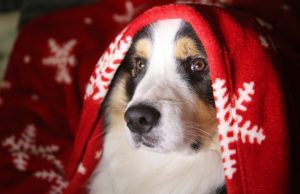
If you need any advice during the Festive period, please call us on:
St Kitts Veterinary Centre: 01252 844044
Basingstoke Veterinary Centre: 01256 844944
Crookham Park Veterinary Centre: 01252 913990
Firgrove Veterinary Centre: 01252 877799
Opening times:
Monday 23rd – Normal Opening Hours
Tuesday 24th – 6pm Close
Wednesday 25th – Vets Now Farnham 01252 737555
Thursday 26th – Vets Now Farnham 01252 737555
Friday 27th – Monday 30th December – Normal Opening Hours
Tuesday 31st – 6pm Close
Wednesday 1st January – Vets Now Farnham 01252 737555
Thursday 2nd January – Normal Opening Hours
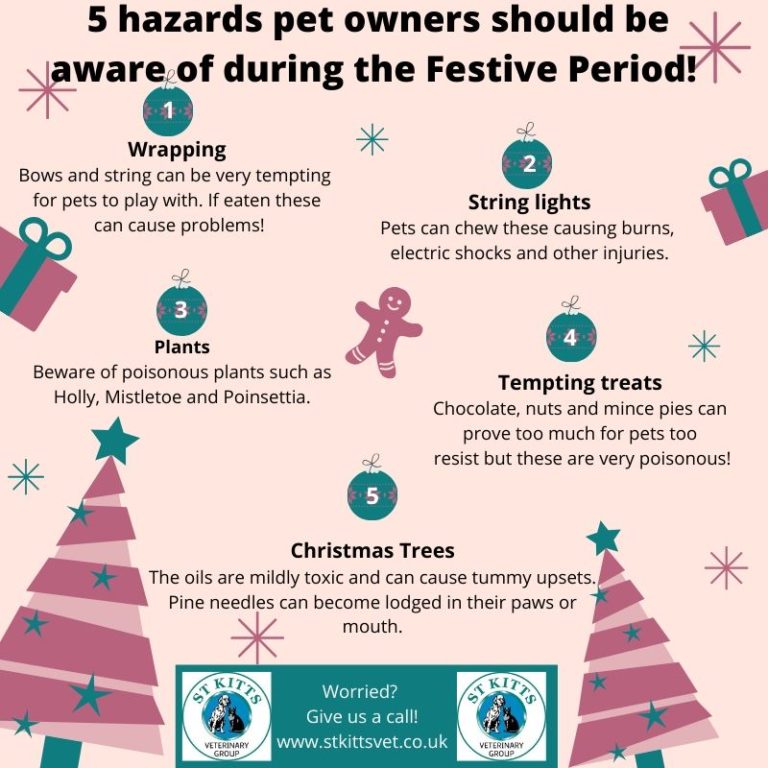

Come and join us for a free evening of simple, powerful advice on weight management for your pet. Delivered by people who care and aren’t judging.
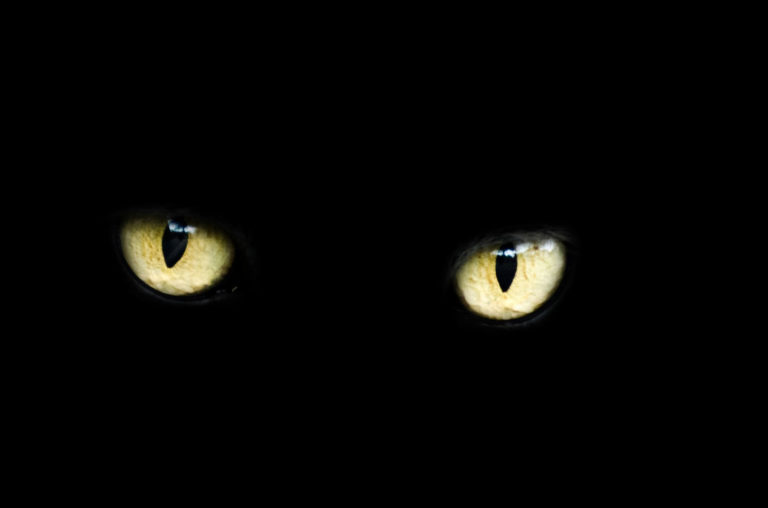
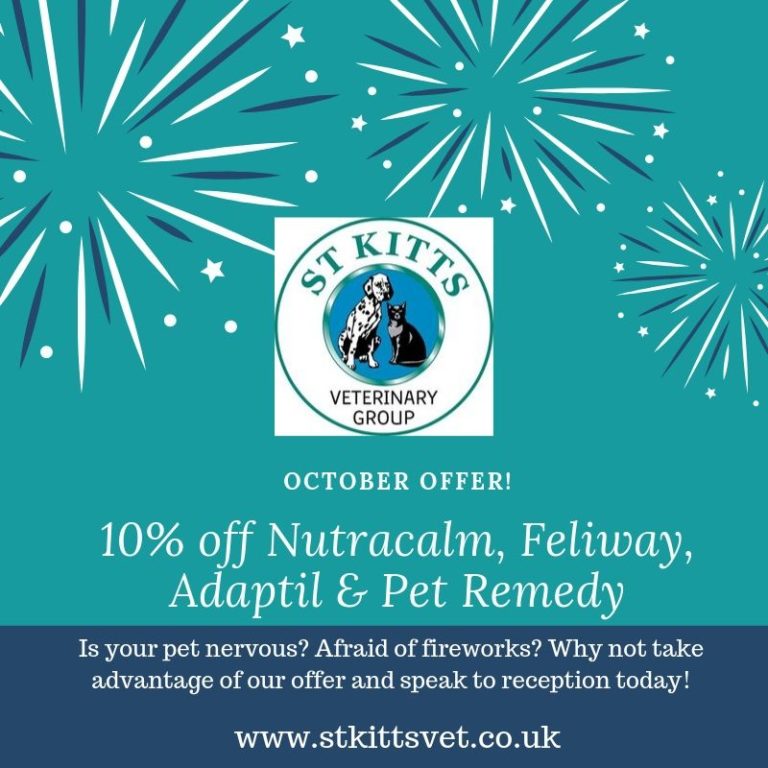
This October we are offering you 10% off all Nutravet, Feliway, Adaptil and Pet Remendy products.
With firework season coming up why not take up our offer?



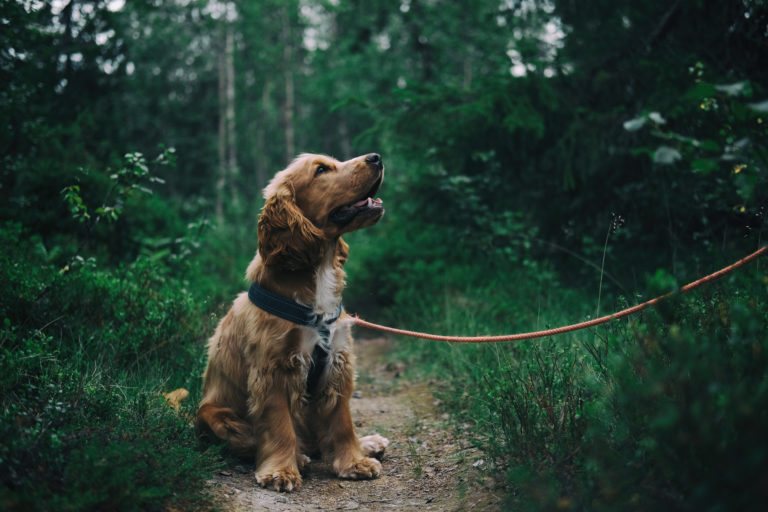
What is Alabama rot?
Alabama rot, also known as CRGV (Cutaneous and Renal Glomerular Vasculopathy) is a life threating disease that affects dogs. The disease results in blood clots which can block and damage blood vessels. This causes damage to the skin resulting in visible ulcerations and it can also affect the kidney’s blood vessels, leading to organ dysfunction and kidney failure. The cause of Alabama rot is unknown. We know it has been reported more in Winter and Spring months, normally when dogs are walked in wet muddy woodland.
What are the symptoms of Alabama rot?
Common areas affected are paws, lower legs, lower body, face, mouth and tongue.
What to do if you suspect your pet has Alabama rot?
It is very important that you contact your vet immediately. If your dog is affected, getting an early examination and treatment plan is essential. Unfortunately, the disease can be fatal and sadly the cause is still unknown, so no cure exists.
Can you help prevent it?
Unfortunately, the cause of the disease is unknown, so there is no guarantee or proven method for avoiding it.
We do know some dogs affected walk in wet muddy woodland, so we suggest:
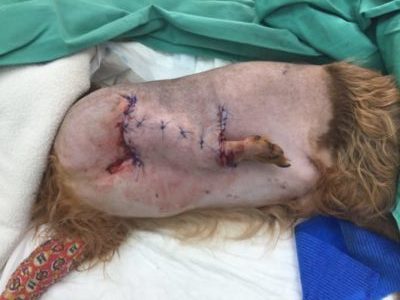
Back in June 2018, our Firgrove vets were presented with an interesting emergency case. Henry, a little seven-year-old Yorkshire terrier cross had injured himself whilst out playing in the garden. He had what we call a ‘degloving’ injury which is where the skin is stripped away from an area, which in his case was on his left front leg. Unfortunately for Henry, the injury was so extensive that the wound affected the entire circumference of his leg. This meant that it would not heal, even with bandaging and wound support. Our vets were left with the decision to amputate, or try a technique called a bi-pedicle skin graft, also known as a pouch graft. His owner was very keen to try to save his leg, so we agreed we would perform the pouch graft.
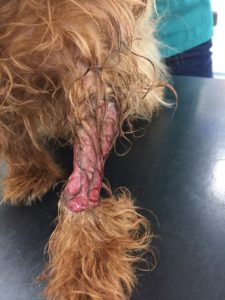
To perform a pouch graft, there are two phases. In phase one, a tunnel is made through the skin of the side of the chest. The leg is then posted through the tunnel so that the tunnel of skin covers the wound. The chest skin is then stitched over the leg so it is secure and left to heal onto the leg for two to three weeks. To do this successfully, we needed to make sure that Henry would manage on three legs comfortably and quietly enough to allow the skin to take. So, after cleaning up the leg and trimming away any dead tissue, before we started the pouch graft, he was bandaged with the leg strapped to his chest for the night to see how he would cope, which we were pleased to say he managed perfectly! The next day we went ahead with phase one of the pouch graft and his leg was stitched into the pouch which healed beautifully. Stage two of the graft involves releasing the leg from the pouch, so long as the skin from the chest has healed onto the leg sufficiently. The leg is released by cutting a rectangle of skin around the leg away leaving enough skin taken from the chest to wrap around the rest of the leg, and the resulting wound on the chest is stitched back together.
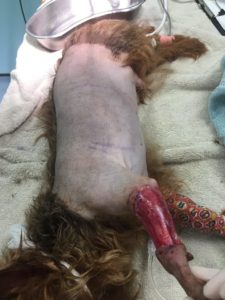
For Henry, his recovery wasn’t easy. The outer part of the graft took nicely on the leg, but the inner portion of the graft struggled with getting a good blood supply, and some dead tissue had to be trimmed away. Fortunately, most of the graft was very healthy, and a bed of tissue had formed underneath the entire graft for new skin to grow over. This meant that the recovery was slightly longer than expected, but over time, with careful dressing changes and the help of some medical grade manuka honey applied to the wound, in addition to Henry’s owner and our team’s complete dedication to saving his leg, the wound healed completely and he is now back to normal.
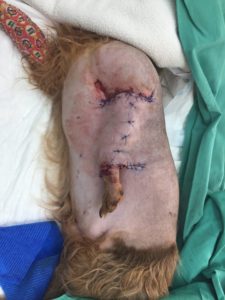
Henry was such a superstar of a patient, he coped incredibly with all the procedures to help save his leg, and we are so happy to say that he is now leading a normal life on all four legs!